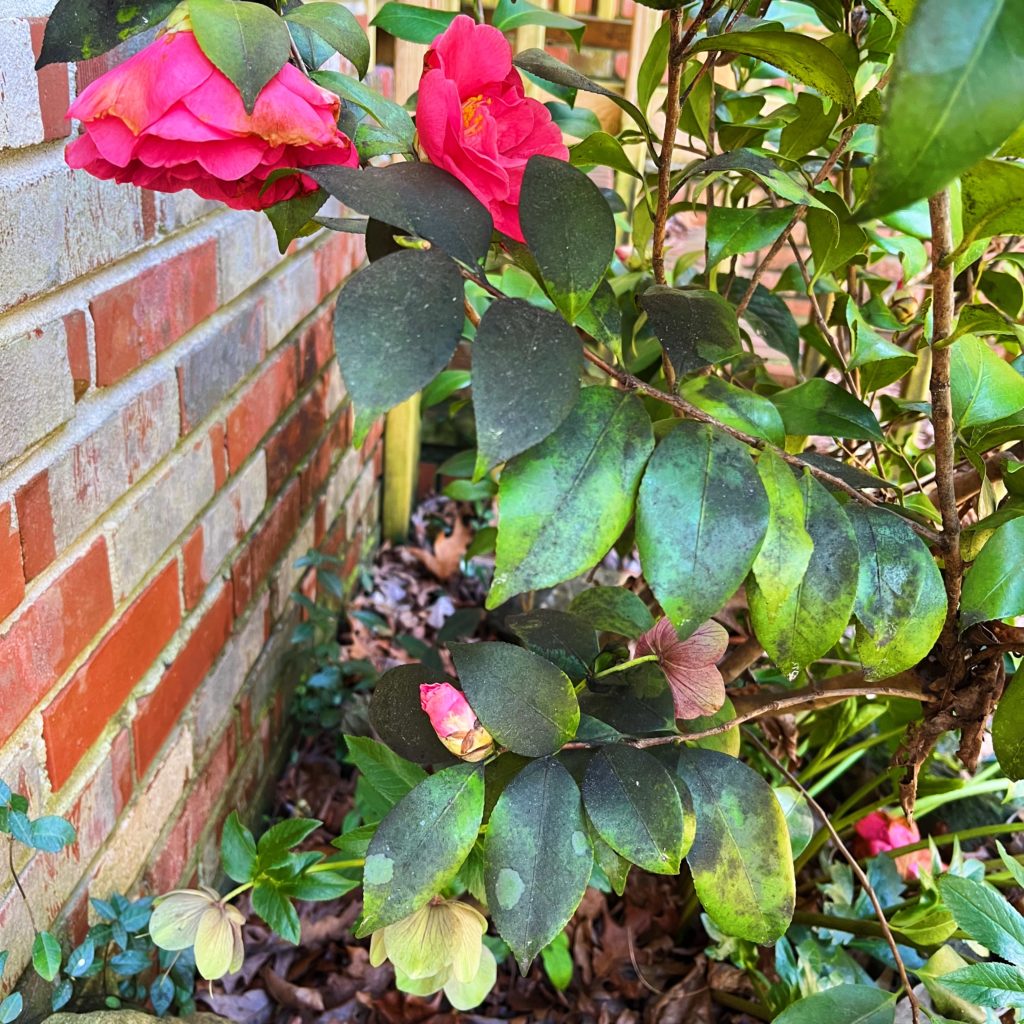
Sooty mold, a common fungal disease, grows on honeydew dropped by sap-sucking insects and inhibits photosynthesis on foliage.
So, what’s the best way to get ahead of the game and keep disease and pests from taking over your garden? Planning and prevention, of course!
By nature of building a more diversified landscape that avoids large swaths of monoculture plantings and incorporates a wider variety of species, you will have already set your space up for resilience, and greater resistance to a spectrum of disease of pests. But, especially with a warming climate, pressure from disease and pests can persist almost year-round. Historically, more consistent hard freezes and colder temperatures over winter help stymie populations of pesky insects and some disease. However, as we continue to experience milder winters with intermittent warming, life cycles of these pests are left unchecked. Earlier increases in springtime temperatures and moisture also provide opportunities for disease and pests to thrive.
That’s why we combine prevention with ecologically minded design. At Shades of Green, we begin preventive spraying and washing of foliage in late March. This period of warmer temperatures and increased rainfall results in higher humidity which is ideal for the beginning life stages of overwintering insects. Plus, given our milder winters, these insects are enjoying extended or double breeding seasons without consistent freezes which serves to increase the pressure they exhort on plants.
We place particular emphasis on areas of yards that retain more moisture, like shady spots and north-facing spaces, where insects and disease are likely to appear. Ever-conscious of potential ecological impacts, and because we don’t use chemicals in our practice and Caretaking program, we typically use a mixture of neem oil and peppermint castile soap diluted with water for spraying. Specifically, the recipe that we’ve found to work best is: 1 tbsp of concentrated, cold-pressed neem oil and 1 tsp of liquid castile soap per gallon of water. In areas historically prone to disease and pests, or in spaces likely to harbor them, we start spraying on a weekly basis. If we observe a particularly bad infestation, we may elect to start a twice weekly regimen.
At the start of the season, the majority of what we see in the field during our prevention-based intervention is sap-sucking pests like aphids and scale. Pests of this kind are part of a fascinating mutual relationship with ants, which ‘farm’ them to meet their own feeding needs. These insects extract chlorophyll from leaves which results in the excretion of sugars. The ants then tickle their pesky aphid pals, causing them to secrete a sugary honeydew that the ants eagerly lap up. It’s one of their very favorite foods!
With this mutualistic relationship in mind, we take care to make detailed observations of the insect activity we see. In fact, observation in and of itself is one of the best tools that a gardener has in terms of managing disease and pests. We encourage daily observation of your landscape, including examination of foliage to check for eggs and other signs of insects. If we observe ants farming aphids or scale, and if we see signs of sap-sucking insects at all, in addition to spraying we spread diatomaceous earth (DE) around the base of the plant and up the stem. And if we see an ant pile we disturb it and powder it with DE, too.
Another common disease we see in landscapes this time of year and beyond is sooty mold. This fungal disease results when, once again, sap-sucking insects like aphids emerge and get to work. This is particularly prevalent in areas like Atlanta with large populations of hackberry (Celtis occidentalis) trees. Wooly aphids, and myriad other pests and diseases, love to feed on hackberries. After feeding on the tree’s leaves, they then secrete honeydew which drops down and sticks to the foliage of understory plants below. Sooty mold then grows on the sticky substance, inhibiting the plant’s ability to photosynthesize. When possible, in addition to spraying to keep infestations of contributing pests at bay, we hand-wash the foliage of plants suffering from sooty mold to remove the disease.
Ultimately, though, one of the best defenses you can provide the plants in your landscape against both disease and fungus is diversification with integrated pest management in mind. Including communities of plants that attract birds and beneficial insects like parasitic wasps and ladybugs serves to strengthen your garden’s ability to thrive and keep issues in check. By taking an ecological, systems-based approach to your landscaping, and by creating an environment that supports soil health and diverse populations of plants, insects and animals, you’ll increase resilience in the face of disease and pest pressure and reduce management needs.
In addition to diversified plantings, proper spacing and pruning can go a long way to both prevent disease and pests and minimize their impact. Allowing for adequate space between individual plants or groupings, as well as pruning for optimum air flow, creates an environment conducive to air circulation which helps to prevent conditions in which diseases thrive.
The hotter and wetter it is, the more we’ll see disease and pests! Take action now to set your landscape up for success this season and beyond with diversified plantings, preventive treatments and proper caretaking protocols. To learn more about disease and pest management and to hear tips and tricks from the field, tune in to our new monthly Instagram live with Caretaking Manager Roxy Drew at @shades_of_green_permaculture starting this Friday, March 25 at 12 p.m. noon!

Tune in to hear Shades of Green Caretaking Manager Roxy Drew answer common questions and share management tips and tricks from the field live on Instagram @shades_of_green_permaculture the 4th Friday of every month!